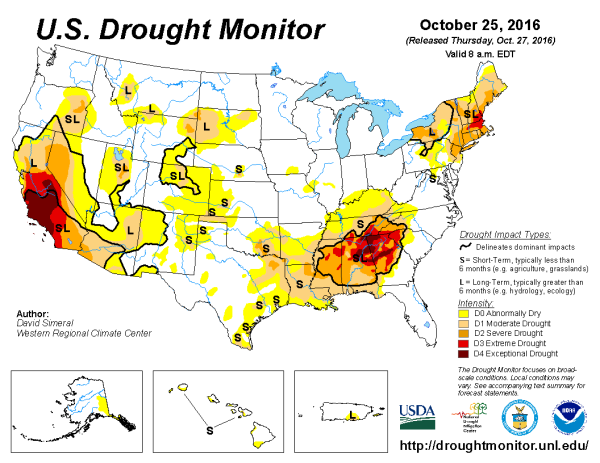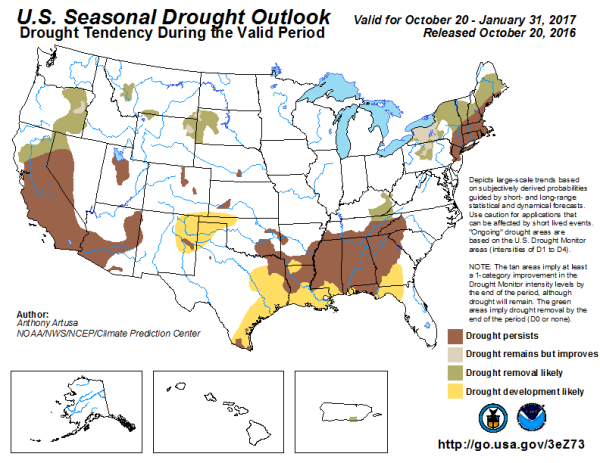California Drought To Enter 6th Year, Colorado River States Struggle to Avert Water Crisis, Southeast Drought Worsens
27
October, 2016
Around
the world, global warming is starting to have a serious impact on
rainfall in the subtropics and middle latitudes. The tropical
atmospheric circulation known as the Hadley Cell is
expanding toward the poles.
This expansion is causing clouds and storms to move further north.
And as a result, regions
in the middle latitudes are starting to dry out.
A changing climate means less rain and lower water supplies in regions where many people live and much of the planet’s food is produced: the mid-latitudes of the Northern and Southern hemispheres, including the U.S. Southwest, southern Europe and parts of the Middle East, southern Africa, Australia and Chile.
Such
a fundamental shift in global weather patterns due to human-caused
climate change is expected to reduce the food and water security of
numerous nations. The World Resources Institute recently warned that
food and water crises were imminent as a result.
And, apparently, these kinds of changes to the world’s weather are
already generating profound shocks in parts of the U.S.
Colorado
River and California Droughts Expected to Persist
For
the Colorado River, this combined warming and movement of clouds
northward has produced a 16-year-long drought. Hotter average seasons
result in greater rates of evaporation. So even if rainfall averages
remain, grounds, lands and rivers are drier. But the Hadley Cell’s
expansion has also moved rain bearing weather systems north.
It’s
a compounding drying influence that has pushed Lake Mead, the
nation’s largest reservoir, to record low levels. And states
dependent on the great river’s water supply for farming and
industry are
now involved in negotiations to avert a water crisis in
2018. Forecasts
predict a 50 percent possibility that Lake Mead’s water levels will
fall below its mandatory rationing line.
Such an event would result in water cut-offs for Arizona and Nevada.
(Over
recent years, the U.S. has experienced numerous severe and
long-running droughts. These worsening drought conditions have
impacted everything from Colorado River levels to wildfires, to the
health of forests, to commerce on the Mississippi River, to the
productivity of state agriculture. As human fossil fuel burning
continues, atmospheric changes will force rainfall toward the poles
which will tend to further worsen drought conditions in
middle-latitude regions like the lower 48 states of the U.S. Image
source: Drought
Monitor.)
In
an attempt to prevent crisis in the coming months, California and
other Colorado River states are attempting to cut water consumption
now. Such a planned regional belt-tightening would help to avert
conflict over the Colorado River’s dwindling stores and smooth out
any losses over time. But, sadly, climate conditions are only likely
to continue to worsen — increasing the risk of mandatory rationing
for 2019, 2020 and beyond.
In
California, a
five-year-long drought that
is the worst in state history now threatens to enter its 6th year.
Rains during 2016 did help to reduce the severity of drought
conditions for some parts of the state. And during recent days, a
series of Pacific storms has helped
to deliver moisture to some northern and central regions.
However, with record warmth settling in over the Arctic and with a La
Nina developing in the Pacific, long range forecasts indicate a high
risk that California will experience a warm, dry winter. Such
predicted conditions would result in a persistence of the present
drought with continued impacts to the state’s forests and
agriculture.
Southeastern
Drought Expected to Expand
(Drought
conditions are expected to worsen across the US Southeast this fall
and winter. Drought in the Colorado River region is expected to
persist or worsen. Drought in California and in parts of the US
Northeast is expected to persist. Image Source: Climate
Prediction Center.)
Further
east, a flash drought that has settled into the US south is expected
to worsen over the coming months. Abnormal warmth in the range of
5-15 degrees (F) above average for the region during the past month
has combined with dry weather to spur severe to extreme drought
conditions over a six state area. Now, parts of Tennessee, North
Carolina, South Carolina, Georgia, Alabama and Mississippi are under
the gun — with drought zones expected to persist or expand
through at least early February.
US
Drought Conditions to Worsen as the Globe Wars
In
total, more
than 120 million people or 28 percent of the population of the lower
48 states is experiencing drought.
And the systemic impacts of multi-year, persistent droughts are
widespread and growing. This drying is consistent with the impacts
associated with a warming climate. And, unfortunately, such worsening
of droughts is likely to continue until atmospheric warming is halted
and/or reversed.
Links:
Hat
tip to Wili





No comments:
Post a Comment
Note: only a member of this blog may post a comment.